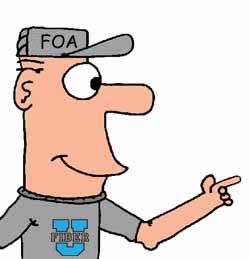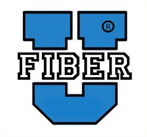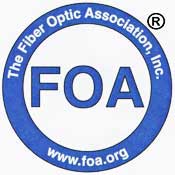Free
Online Self-Study Courses
Fiber U is
the free online learning website of the
FOA -
the Fiber Optic Association, the international
professional association and certifying body devoted to the development
of a skilled workforce in fiber optics and telecommunication.
Here you will find free
online self-study courses, tutorials, textbooks, videos and
links to other FOA pages that will help you learn about fiber
optics and premises cabling.
Looking
for a specific topic? Try the Fiber U Roadmap below.
Click on an
area of interest to learn more about the Fiber U course in that
topic. Don't miss the MiniCourses
below too.
Roadmap
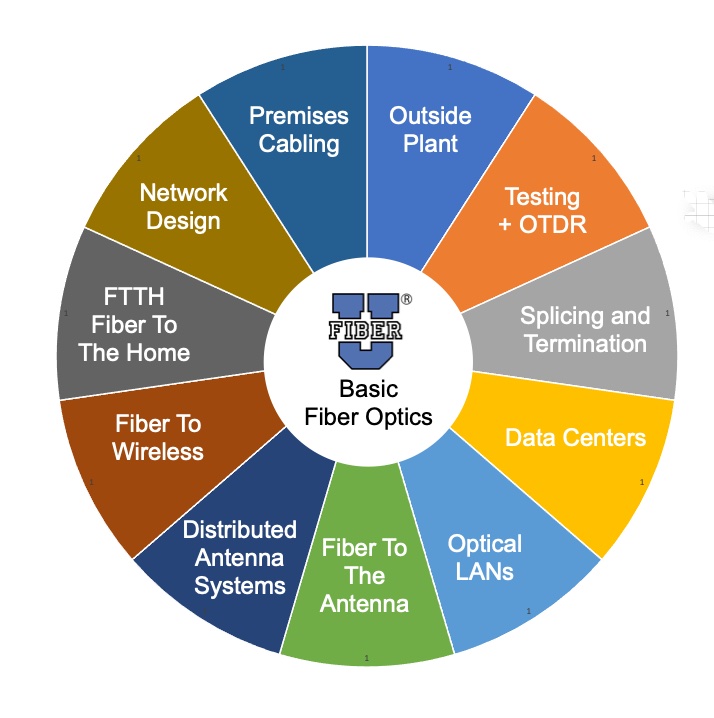
The
free Fiber U self-study courses are in these categories:
Introduction
To Fiber Optics
- for those getting started in fiber optics
Basic
- Fiber Optics (NUEVO
- ¡Ahora en español!) or Premises
Cabling, both including Basic Skills Labs (fiber
optics and premises cabling)
Skills
- Fiber Optic Testing ( with special
programs on Fiber Characterization (new) and OTDRs), OSP
Construction and OSP Installation
Fiber
Optic Network Design - including case studies
Applications
-
Fiber to the Home (FTTH),
Fiber
For Wireless, Distributed Antenna Systems
(DAS), Fiber to the Antenna (FTTA), Data
Centers,
Optical LANs
MiniCourses
- Short courses on important topics about fiber optic network
design, installation, test and operation that you can finish in
an hour or less: Fiber Optic Jargon, How Optical Fiber Works, Fiber
Optic Color Codes, Fiber
Optic Connector Identification, Fiber Optic
Connector Inspection And Cleaning. The
Mysterious dB of Fiber Optics, Reading
An OTDR Trace, Fiber
Optic Link Loss and Power Budgets, Fiber
Optic Media Conversion, Fiber
Optic Cable Bend Radius, Fiber
Optic Cable Midspan Access and Fiber
Optic Network Restoration.
Reference Cables For Fiber Optic Testing, Fiber Optic Attenuators New:
Fiber Optic Project Management
New:
OJT Courses in fiber optics and
premises cabling
Fiber
U Certificate of Completion When you finish
a free Fiber U online self-study program, you can take a test to
get a Fiber U Certificate of Completion for the course for a
nominal charge to cover our online testing service.
Certification
-
Fiber U courses may be used as preparation for the FOA
certification programs as noted in the descriptions.
- References
- Fiber U courses are based on the
extensive FOA knowledge base on fiber optics, including the FOA
textbooks and online FOA Guide.
- About
Fiber U - The history and goals of FOA's
online learning site
Most
courses are aimed at helping study for the corresponding FOA
certifications. Each course has an estimate of the typical times
to complete the course. Many courses assume a knowledge of basic
fiber optics so the newcomer may want to start with the Basic
Fiber Optics course below.

Who
is Lennie Lightwave? Lennie
Lightwave was the cartoon mascot created for the original Fiber
U conference in 1993.
All Fiber U material and programs are copyright FOA. For
information on fair use of this material, go
here.
FOA/Fiber U Privacy Policy
Introduction
To Fiber Optics: Fiber
Optics In Communications
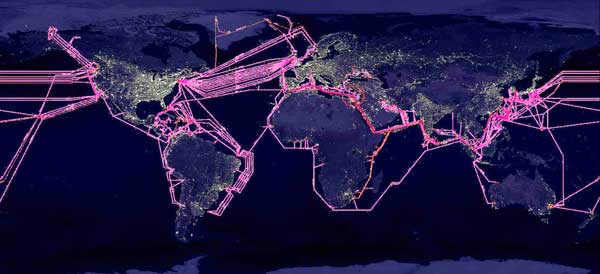
Fiber
Optics In Communications
and How It Works
(1 hour)
Just
getting started in fiber optics and wonder where it's used and
how it works? Are you managing a fiber project and want to
understand what is involved? Does your organization use fiber
optics and you'd like to know more about how it works? This
short introductory lesson from Fiber U is intended for you. Not
too technical, just an overview, but a good starting place for
everyone interested in fiber optics.
Fiber
U "Basic Fiber Optics" Self-Study Program -
NUEVO - ¡Ahora en
español!
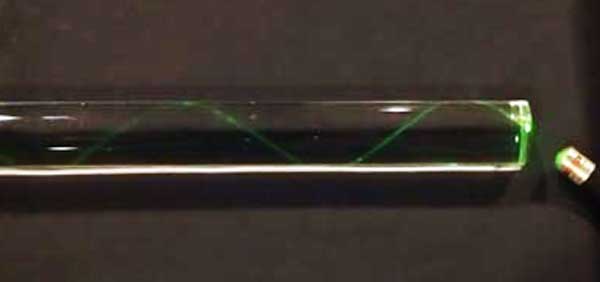
Basic
Fiber Optics
(10-20 hours)

May
be used with the FOA "OJT to Cert" and "Work to Cert" programs and as preparation for the CFOT®
Certification Exam
This is a
10-part series of self-study lessons covering the basics of fiber
optics. You can use the FOA Online Reference Guide to Fiber Optics
or a copy of the textbook The FOA Reference Guide to Fiber
Optics, available in printed or Kindle eBook form. Study the
reference materials and test your comprehension with the online
quizzes. This course was designed for those just getting started
in fiber optics, as a preparation for those taking the CFOT
Certification directly or planning to attend an FOA-approved
course and want to prepare ahead of time.
Complete
the course and you can take the Fiber
U Certificate of Completion test.
NUEVO
- ¡Ahora en español!
Fibra
Óptica Básica
(10-20 horas)
Puede usarse como preparación para el examen de certificación
CFOT®
Esta es una serie de 10 lecciones de autoaprendizaje que cubren
los conceptos básicos de la fibra óptica. Puede utilizar la Guía
de referencia de fibra óptica en línea de la FOA o una copia del
libro de texto La Guía de referencia de la fibra óptica de la FOA,
disponible en formato impreso o de libro electrónico Kindle.
Estudie los materiales de referencia y pruebe su comprensión con
los cuestionarios en línea. Este curso fue diseñado para aquellos
que recién comienzan en fibra óptica, como una preparación para
aquellos que toman la Certificación CFOT directamente o planean
asistir a un curso aprobado por FOA y quieren prepararse con
anticipación.
Complete el curso y podrá realizar el examen de Certificado de
finalización de Fiber U.
Fiber
Optic Skills Lab
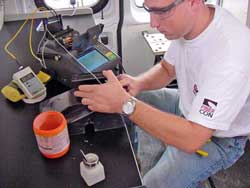
Fiber
Optic Skills Lab
Covers
Safety, Tools, Cable Preparation, Splicing, Termination and
Testing
May
be used as supplemental material in preparation for the CFOT®,
CFOS/S,
CFOS/C,
CFOS/T
Certification Exams
(Hands-on,
10-20 hours, each lesson 2-5 hours)
Includes
Do it Yourself lab using inexpensive tools and components you can purchase
online. Includes two link demos: a basic fiber optic link and a PON network.

While you
cannot learn hands-on installation skills necessary for fiber
optic techs by taking an online course, if your
company or you
already have the equipment, the Fiber
U Basic Skills Lab can help you learn on your own. In this
course you download a workbook and use FOA Guide, YouTube Videos
and "Virtual Hands-On" tutorials to give you step by step
instructions and lots of hints on how to prepare cables, splice,
terminate and test them, then build a working fiber optic
network.This course is designed for those who have already
completed the Basic
Fiber Optics course above, have access to equipment and a
variety of components and want to learn the processes of fiber
optic installation on their own. If you are preparing to take a
in-person course from one of the FOA approved schools, you can use
this course to familiarize yourself with the labs taught in the
courses.
This course includes
Do it Yourself labs using inexpensive tools and components you can purchase
online. It includes two link demos: a basic fiber optic link and a PON network.
Complete the course and you can take the Fiber
U Certificate of Completion test.
Premises
Cabling
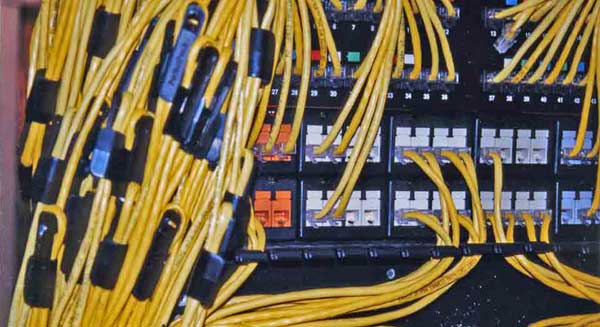
Premises
Cabling (Copper, Fiber And Wireless)
(5-10 hours)

May
be used as preparation for the CPCT
Certification Exam
This 8-part self-study program covers premises
cabling, including copper (UTP and coax), fiber and wireless (or
more precisely, cabling for wireless.) This program uses the FOA
Online Reference Guide to Fiber Optics, Premises Cabling Section
or a copy of the FOA
textbook The FOA Reference Guide to Premises Cabling, available
in printed or Kindle eBook form. Study the reference materials and
test your comprehension
with the online quizzes.
Additional reading is included for advanced study.
Complete the course and you can take the Fiber
U Certificate of Completion
test .
Premises Cabling
Skills Lab
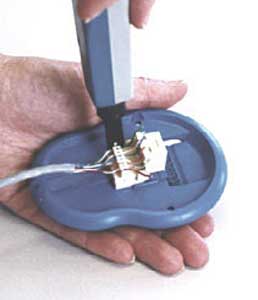
Premises
Cabling Skills Lab, Copper Cabling
Covers safety, tools,
coax, UTP cables, plugs and jacks.
(Hands-on,
5-10 hours, each lesson 1-5 hours)
Includes Do it Yourself lab using inexpensive tools you can
purchase online.

May
be used as
supplemental material in preparation
for the CPCT
Certification Exam
The Fiber U Premises Cabling course
includes copper cabling, fiber cabling and wireless. The fiber
optic cabling is inclded in the Basic Fiber Optics course and The
Basis Fiber Optics Skills lab. This course covers basic skills for
unshielded wtisted pair (UTP) copper cable (what is often called
"Cat 5" cable) and coax for video. This course can
help you learn on your own. In this course you download a workbook
and use FOA Guide, YouTube Videos and "Virtual Hands-On" tutorials
to give you step by step instructions and lots of hints on how to
prepare cables, splice, terminate and test them.This course is
designed for those who have already completed the Premises
Cabling course above, have access to equipment and
a variety of components and want to learn the processes of fiber
optic installation on their own. If you are preparing to take a
in-person course from one of the FOA approved schools, you can use
this course to familiarize yourself with the labs taught in the
courses.
Complete
the course and you can take the Fiber
U Certificate of Completion
test .
Fiber
U "Specialist" Skills-Based Courses
Outside Plant FIber Optics
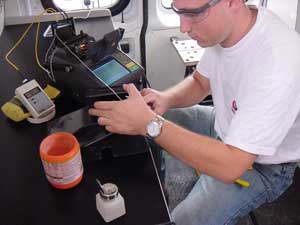
Outside
Plant Fiber Optics
(10-20 hours, 5-10 if Basics of Fiber above is completed first*)

May
be used as preparation for the CFOS/O
Certification Exam
This 10-part self-study program on outside plant fiber
optics covers the outdoor networks used by telcos, wireless
operators, CATV companies, utilities, etc. and the processes
used in their installation. This program uses the FOA
Online Reference Guide to Fiber Optics, OSP Section
or a copy of the FOA textbook The
FOA Reference Guide to Outside Plant Fiber Optics,
available in printed or Kindle eBook form. Study the reference
materials and test your comprehension
with the online quizzes.
Additional reading is included for advanced study.
Note:
this is an expanded version of the Basic Fiber Optics program
above to include specific issues of OSP installation. If
you have completed the Basics of Fiber Optics course
above, the time to complete this program is less because
the introductory information is the same.
Complete the course and you can take the Fiber
U Certificate of Completion
test.
Outside
Plant Construction
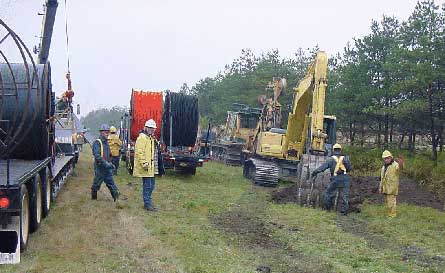
Outside
Plant (OSP) Construction
(5-10
hours)

May
be used as supplemental material in preparation for the CFOS/O
Certification Exam
This
program covers the process of construction of outside plant
(OSP) fiber optic cable plant including underground, direct
buried and aerial installations. The
Outside Plant Fiber Optics program above continues from this
course to cover OSP installation from the point of preparing the
cable, splicing, termination and testing.
Complete the course and you can take the Fiber
U Certificate of Completion
test.
Fiber
Optic Testing
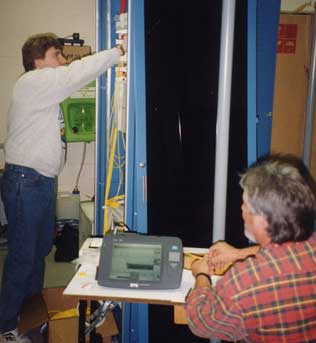
Fiber
Optic Testing
(10-20 hours)

May be used as preparation for the CFOS/T
Certification Exam
Prerequisite:
Basic Fiber Optics above, or comprehensive knowledge of fiber
optics.
The
Fiber U Fiber Optic Testing self-study program is aimed at
everyone working in fiber optics. This 6 part series of lessons
covers the full scope of fiber optic testing, one of the most
complex topics in fiber optics. The course is divided into lessons
that cover an overview of fiber optic testing, test tools and
instruments, visual testing, insertion loss, OTDRs and a catch-all
final lesson covering a number of other topics. The course uses
the FOA textbook The FOA Reference Guide To Fiber Optic
Testing, ,
available in printed or Kindle eBook form, the FOA Online
Guide and FOA YouTube Videos to provide the
basic materials for study but we also provide links to many
additional topics that may apply to your particular applications.
For those just interested in OTDRs, there is a separate program on
that subject below.
Complete the course and you can take the Fiber
U Certificate of Completion
test.
Fiber Characterization

Fiber Characterization
(2-4 hours)

Prerequisite: Fiber U Fiber Optic Testing Course or equivalent
For high-speed networks operating over very long
distances, new factors limiting fiber performance become
important. Chromatic dispersion, the dispersion caused by
light of different wavelengths, and polarization mode
dispersion, caused by the polarization of the light in the
fiber, become factors limiting the bandwidth capacity of
fiber links. Pulse broadening due to chromatic dispersion
and the variation of fiber attenuation with wavelength can
become issues with DWDM. A suite of tests for these factors has been developed to
test fibers for long distance high-speed networks. These
tests are normally called “fiber characterization,” but
technically they are “fiber optic cable plant
characterization” since it must include the complete
end-to-end cable plant. That is what this course will cover.
Complete the course and you can take the Fiber
U Certificate of Completion
test.
Understanding
OTDRs
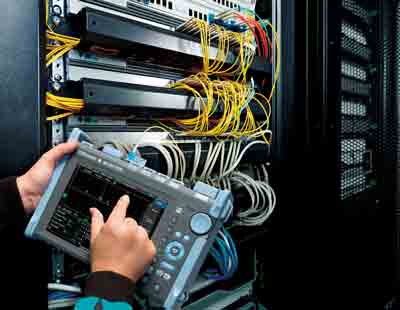
Understanding
OTDRs And OTDR Testing
(2-4 hours)

This
is a lesson from the Fiber Optic Testing course above that
just covers OTDR testing.
Prerequisite:
Basic Fiber Optics above, or comprehensive knowledge
of fiber optics.
May be used as supplemental material in preparation for
the CFOS/T
Certification Exam
This is a 4-part series on understanding
one of the more important testing tools in fiber optics. OTDRs are
valuable test tools but require more depth of understanding to use
properly. This self-study program will review fiber optic testing,
look at how OTDRs work and how their test data is analyzed. It
also explains testing artifacts like "gainers" and "ghosts" that
can be very confusing. The
course uses the FOA textbook The FOA Reference Guide To
Fiber Optic Testing, ,
available in printed or Kindle eBook form, the FOA Online
Guide and FOA YouTube Videos to provide the
basic materials for study but we also provide links to many
additional topics that may apply to your particular
applications.
Included with this course is a free OTDR simulator you can
download and run on your Windows PC.
Complete the course and you can take the Fiber
U Certificate of Completion
test.
Fiber
Optic Network Design (For Designers And Management)
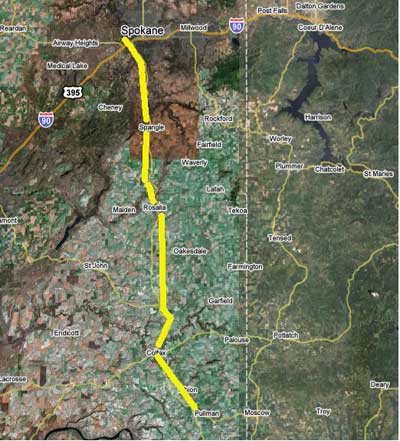
Fiber
Optic Network Design
(5-15
hours)

May be used as preparation for the CFOS/D
Certification Exam
This 8-part series of self-study lessons is aimed at designers
and managers needing to know how to design, install and
operate a fiber optic network. It's about how to evaluate
customer needs for communications links, choose equipment, design
the cable plant, choose components, create a plan, choose
contractors, pick components, manage the install and finish the
paperwork. It's
not how to create drawings - that's another part of design but
specific to the software or method used to create drawings!
The final lesson is 9 case studies of various networks where you
have to make the right choices. The
course uses the FOA textbook The FOA Reference Guide To
Fiber Optic Network Design,
available in printed or Kindle eBook form, the FOA Online
Guide and FOA YouTube Videos to provide the
basic materials for study but we also provide links to many
additional topics that may apply to your particular
applications. This course assumes you have a basic
knowledge of fiber optics at the CFOT/CPCT level. If not, take the
Basic
Fiber Optics or Outside
Plant Fiber Optics course above.
If
you are interested in taking this course for FOA CFOS/D direct
"Work-To-Cert" certification, contact FOA at info@foa.org.
Complete
the course and case studies and you can take the Fiber
U Certificate of Completion
test.
Fiber
Optic "Specialist" Applications-Based Courses
Recommended
preparation: Basic knowledge of fiber optics, e.g. Basic
Fiber Optics course above.
Fiber To The Home,
etc.
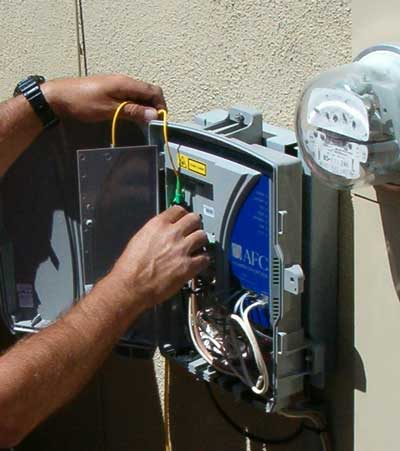
FTTx
Fiber To The Home, Premises, Business, Curb, etc.
(3-5
hours)

May
be used as preparation for the CFOS/H
Certification Exam
This 6-part series will
introduce you to the varieties of ways that fiber optics is moving
closer or all the way to the subscriber. While some refer to it as
FTTH (fiber to the home), we also have FTTC (curb), FTTP
(premises) and even a new acronym, FTTW (wireless), and this
self-study program will cover all the varieties. While all
varieties of FTTx are covered, most of the course focuses on FTTH
PON networks. Take this course and you will learn about all the
options for FTTx, what network architectures look like, what
standards exist, and get an overview of how they are installed and
tested. A final session will cover design of FTTx and give you a
design exercise to complete. This course is designed for everyone
interested in FTTx. Those new to fiber optics or in management
roles can use this course to familiarize themselves with FTTx
technologies, while those with fiber backgrounds will learn how to
implement FTTx from this course. The
course uses the FOA textbook The FOA Reference
Guide To Outside Plant Fiber Optics,
Appendix B, available in printed or Kindle eBook
form, the FOA Online Guide and FOA YouTube
Videos to provide the basic materials for study.
Complete
the course and you can take the Fiber U Certificate of
Completion
test.
Fiber
For Wireless

Fiber
For Wireless
(2-5
hours)

May be used as preparation for the CFOS/W
Certification Exam
Wireless communications is growing at an incomprehensible pace.
Cellular wireless is looking at upgrades to 5G technology, small
cells and video streaming. WiFi is reaching gigabit speeds for
enterprise LANs, being deployed in many metro areas and even being
used for line-of-sight links in rural areas. All these
applications depend on fiber optics for backbones. This new Fiber
U self-study program combines the current programs on FTTA (fiber
to the antenna) and DAS (distributed antenna systems) and adds
lessons on Small Cells, the hottest topic in cellular wireless,
and WiFi applications. This course is aimed at communications
managers and fiber optic contractors who want an overview of how
wireless technologies depend on fiber optics and how to implement
these systems.
Complete
the course and you can take the Fiber
U Certificate of Completion
test.
Distributed
Antenna Systems
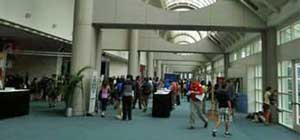
Distributed
Antenna Systems (DAS)
(1-2
hours)

May be used as preparation for the CFOS/W
Certification Exam
Cellular data traffic growth has been phenomenal - over 500 times
in the first seven years of smartphones. While most antennas are
outdoors, most call originate from indoors. While everyone expects
cellular connections everywhere, signals have trouble getting
inside large buildings, mass transit tunnesl, etc. and regular
cellular systems are overloaded in facilities where large groups
gather, such as sports facilities or convention centers. The
solution to both problems is to install distributed antenna
systems that provide adequate coverage no matter how big the crowd
or where they are. This Fiber U course covers how a DAS works, its
cabling requirements and how they are installed.
Complete the course and you can take the Fiber
U Certificate of Completion
test.
Fiber To The Antenna
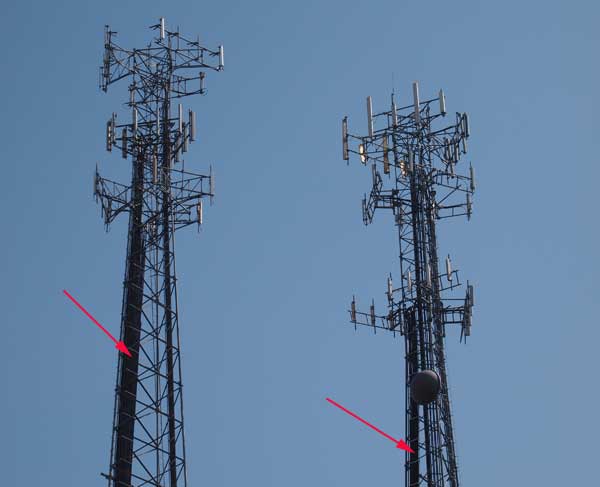
Fiber
To The Antenna
(2-4 hours)

May be used as preparation for the CFOS/W
Certification Exam
Similar to DAS (above), cell towers have been changing to adapt to
the large growth in volume of data traffic over cellular networks.
Towers that one had 3 antennas now have a dozen or more.
Connecting to those antennas from the base of the tower with
traditional coax cables required too much weight and wind
resistance for the tower, not to mention cost, so digital systems
using fiber optic cables have been replacing the coax. This Fiber
U course covers the equipment mounted on cell towers,how cabling
connects them and how those cables are installed and tested.
Complete
the course and you can take the Fiber
U Certificate of Completion
test.
Data Center Cabling
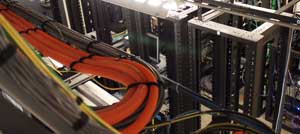
Data
Center Cabling
(2-4
hours)

May
be used as preparation for the CFOS/DC
Certification Exam
Data
centers are one of the fastest growing areas in information
technology and communications, leading to many large
applications for cabling. There are many different
viewpoints on how data center cabling should be designed and
installed, depending on the point of view. Fiber U takes a
unbiased viewpoint to try to understand how users are
actually building data centers and creates a short
self-study program that can provide a better basis for
understanding this important cabling application.
Complete the course and you can take the Fiber U
Certificate of Completion
test.
Optical
LANs
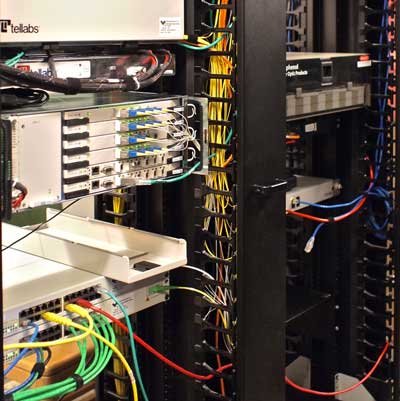
Optical
LANs (OLANs)
(3-5
hours)

May
be used as preparation for the CFOS/L
Certification Exam
Optical LANs or OLANs, are a new
way to build LANs using an all optical fiber cable plant and
electronics derived from fiber to the home (FTTH). Sometimes also
referred to as fiber to the desk or FTTD, POLs, POLANs, passive
optical LANs or FTTO, fiber to the office, these are LANs (local
area networks) that are based on optical fiber cabling, not
copper, and are of great interest to many contractors, installers
and end users. This course will provide an overview of the three
types of optical LANs, their advantages over traditional LANs and
how to design, install and test them.
Complete the course and you can take the Fiber
U Certificate of Completion
test.
Fiber U -
MiniCourses
Fiber U
"MiniCourses" are self-study programs on specialized topics you
can complete in an hour or less.
You can get a Fiber U Certificate of Completion for
these
MiniCourses for $10US.

Fiber Optic Jargon
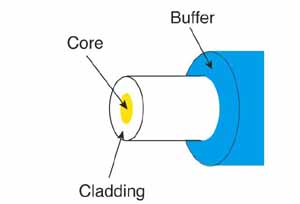
The
key to understanding any technology is understanding the language of
the technology – the jargon. This Fiber U MiniCourse gives you an
overview of fiber jargon to introduce you to the language of fiber
optics and help you understand what you will be hearing when
communicating with fiber optic designers, contractors, installers, distributors and manufacturers.
Fiber Optic Project Management
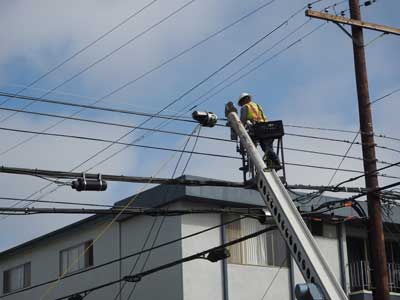
Fiber Optic Project Management
(1 hour)
Managing
a fiber optic project can be the easiest part of the
installation if the design and planning have been
done
thoroughly and properly, or, if not, it can be the
the hardest. It's certainly important to understand what managing a
project entails.
How
Optical Fiber Works
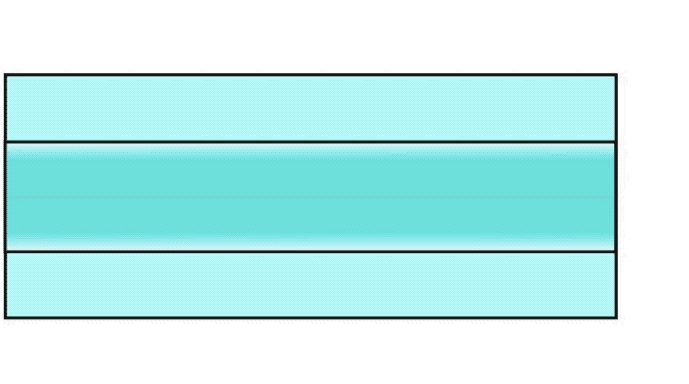
How
Optical Fiber Works
(1
hour)
How does optical
fiber capture light in the core of the fiber and transmit light
long distances? This Fiber U Minicourse explains how fiber works
simply with an animated video that clearly illustrates the
principles that make fiber of all types work. You
can get your Fiber U Certificate of Completion too, for $10.
Fiber Optic Color Codes
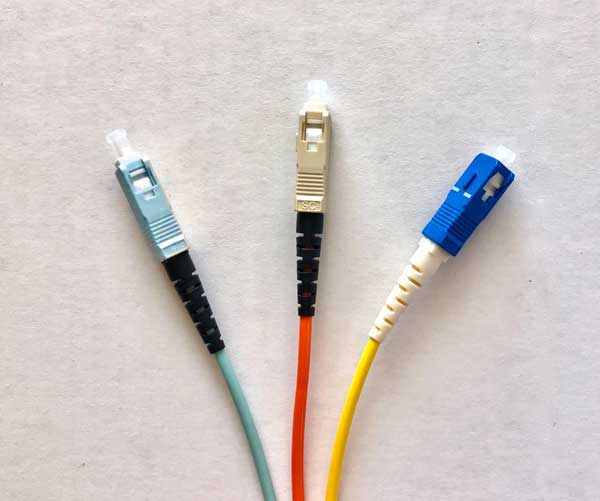
Fiber
Optic Color Codes
(1 hour)
Color
codes are used for identifying fibers, cables, splices and
connectors, ensuring correct connections. Color codes are also an
important part of fiber optic cable plant documentation. This
Fiber U MiniCourse covers the standard colors of fiber optics and
how they are used to ensure network connections. You
can get your Fiber U Certificate of Completion too, for $10.
Fiber
Optic Connector Identification
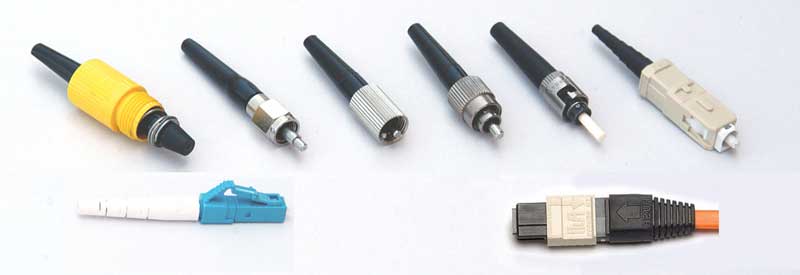
Fiber
Optic Connector Identification
(1 hour)
Over the history of fiber optics, there have
been more than 100 unique designs for fiber optic connectors.
Fortunately only a few have become widely used, but field techs
often encounter connectors they are not familiar with. This Fiber
U MiniCourse covers the most popular connectors today and some
that have been widely used in the past that techs often contact
FOA asking for help in identifying them. You
can get your Fiber U Certificate of Completion too, for $10.
Fiber Optic
Connector Inspection And Cleaning
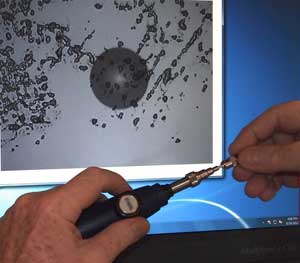
Fiber Optic
Connector Inspection And Cleaning.
(1 hour)
Optical fibers are as small as a human
hair and the performance of fiber optic connections is highly
susceptible to dirt and contamination. This course describes the
types of connector problems caused by dirt, contamination and
damage, how to perform visual inspection of connectors and how to
use proper methods to clean them.
You
can get your Fiber U Certificate of Completion too, for $10.
The
Mysterious dB of Fiber Optics
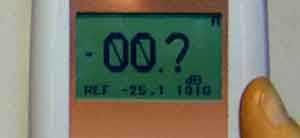
The
Mysterious dB of Fiber Optics MiniCourse
(1 hour)
Fiber optic measurements of power and loss are made in dB, a
mysterious unit of measurement that confuses many people. This
MiniCourse helps you understand what dB and dBm are, how they
are defined and measured. The course also explains how small
change in an international standard created confusion and
misunderstanding of dB. Even if you aren't a math whiz, this FOA
MiniCourse can help you understand dB. You
can get your Fiber U Certificate of Completion too, for $10.
Reference Cables For Fiber Optic Testing - New
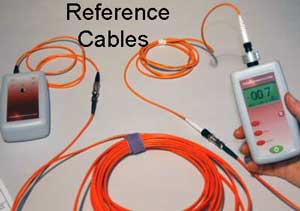
Reference Cables For Fiber Optic Testing
(1 hour)
When testing a fiber optic cable plant, the test
setup looks very similar to the way a fiber optic data link uses the
cable plant, with the communications equipment replaced with fiber optic
test equipment and the patchcords connecting the communications
equipment replaced by reference test cables. This Fiber U MiniCourse
covers the uses, specifications and handling of reference cables for
fiber optic testing. You
can get your Fiber U Certificate of Completion too, for $10.
Reading An OTDR Trace
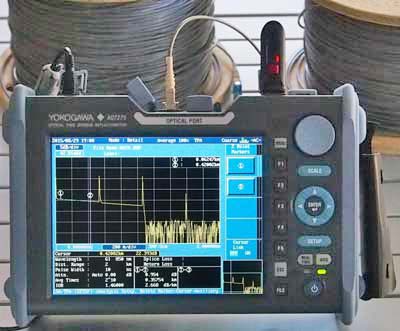
Reading
An OTDR Trace
(1 hour)
The
information provided is an OTDR trace is
quite valuable if you know how to
interpret this. The first thing you need
to know is what the elements in an OTDR
trace are, which is the subject of this
FIber U MiniCourse. You
can get your Fiber U
Certificate of
Completion for $10.
Fiber
Optic Link Loss and Power Budgets
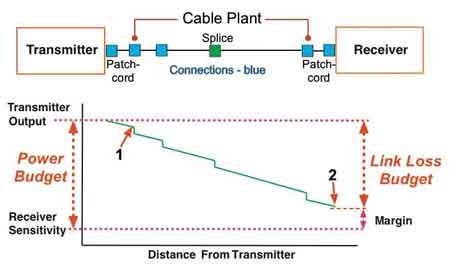
Fiber
Optic Link Loss and Power Budgets
(1 hour)
Fiber optic link loss budgets and
power budgets are very important for designing and testing fiber
optic networks. During the design phase, the power budget of a
network intended to be used on the cable plant being designed is
necessary to compare to the link loss budget of the cable plant
to ensure the cable plant and the network are compatible and
there is sufficient loss margin for operation of the network.
After the cable plant is installed, the link loss budget is used
as the criteria for testing the loss of all the fibers in the
cable plant, all of which should be within the loss
budget. This
course will introduce the concepts of link loss and power
budgets and show how they are used in designing and testing
fiber optic networks. It is intended for designers of fiber
optics networks and techs who will be testing these networks.
You
can get your Fiber U Certificate of Completion too, for $10.
Fiber Optic Attenuators New
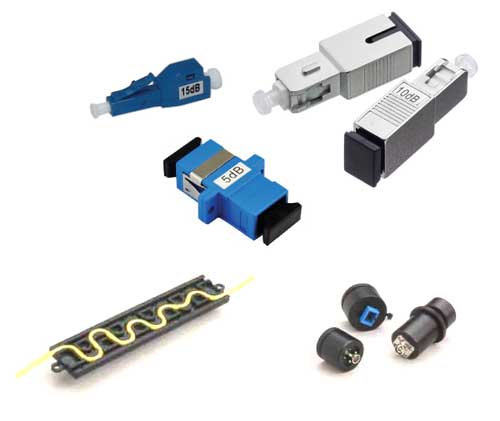
Fiber Optic Attenuators For Managing Data Link Power
Most of
our attention in a data link focuses on the cable plant, particularly
minimizing the loss of the installed cable plant. However many fiber optic links
have too much power at the receiver, a consequence of having links
designed for long distances being used at shorter distances.
This course will discuss the need for attenuators, how to determine the
value of attenuator needed and how to install and test them in the
link. You
can get your Fiber U Certificate of Completion too, for $10.
Fiber Optic Media Conversion
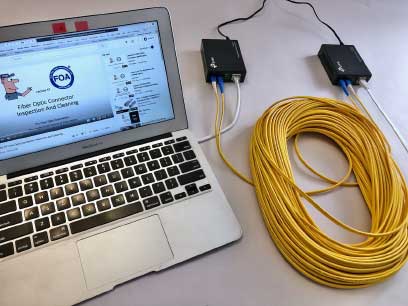
Fiber
Optic Media Conversion
(1 hour)
Electronic devices communicate
internally using electrons on conductors and communicate with
other devices using copper cables. radio waves (wireless) or fiber
optics. These
often require connections into fiber optic networks since fiber
optics is the backbone of the world's communications.
This course describes these converters and how to use
them.
You
can get your Fiber U Certificate of Completion for $10.
Fiber
Optic Cable Bend Radius
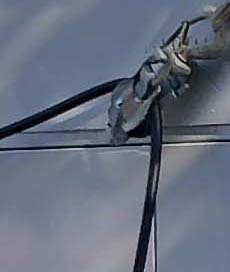
Fiber
Optic Cable Bend Radius
(1 hour)
All fiber optic cables have
specifications that must not be exceeded during and after
installation to prevent irreparable damage to the cable. This
includes pulling tension, minimum bend radius or diameter and
crush loads. Installers must understand these specifications and
know how to install cables without damaging them. Bending of a
fiber optic cable can damage the cable if the curvature of the
bend is too small. Damage may not always be obvious, like a kink
in the cable, but may include broken fibers, fibers with higher
loss due to stress and cable structural damage that may lead to
reliability problems. You
can get your Fiber U Certificate of Completion too, for
$10.
Fiber
Optic Cable Midspan Access
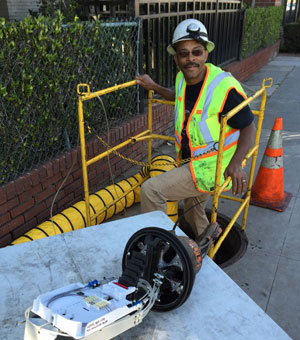
Fiber
Optic Cable Midspan Access
(1 hour)
Many installations
involve splitting the fibers in a backbone cable or
dropping a small fiber count cable from a large
backbone cable. This Fiber U MiniCourse will
explain how a high fiber count backbone or
distribution cable can drop just a few fibers at a
location without splicing all the fibers in the cable,
saving time and cost. You
can get your Fiber U Certificate of Completion
for $10.
Fiber Optic Network Restoration
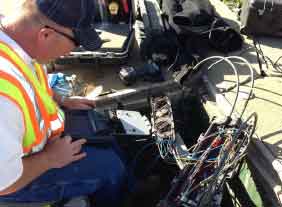
Fiber
Optic Network Restoration
(1 hour)
Every fiber
optic network is susceptible to outages, either by damage to the
cable plant or problems with the communications equipment. This
Fiber U MiniCourse covers what kinds of damage occurs to a fiber
optic communications network, how to plan for outages and
restoration and how to troubleshoot and repair problems. This
course is aimed at managers and network owners as well as
contractors and installers. You
can get your Fiber U Certificate of Completion too, for $10.
OJT -
On-The-Job-Training
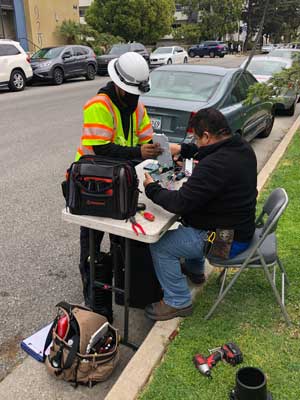
OJT
is the well-known term for "on-the-job training." Workers learn on
the job under the supervision of experienced co-workers. FOA has
been asked many times how its resources like Fiber U can be used
to help employers and their employees involved in OJT. The
interest in OJT has been so high, especially during the difficult
year in 2020, that FOA decided to formalize an OJT program and
create training aids to help employers develop qualified techs
using OJT.
The
Fiber U OJT program
combines online study at Fiber U with OJT to help new employees
develop into certified technicians in only one year. Upon
completion of this program, the trainee will be prepared to take
the exam for the FOA CFOT, Certified Fiber Optic Technician, the
most widely recognized fiber optic certification in the industry.
To
explain How OJT works and FOA's OJT-To-Cert program, FOA created
a short 10 minute YouTube video that explains what OJT is, who
uses it and how to use Fiber U to organize and enhance OJT for
new employees and experienced workers too: On
The Job Training For Fiber Optics Using Fiber U (video)
Fiber
Optic OJT - On The Job Training Course
Premises Cabling OJT - On
The Job Training Course

Get a
"Certificate of Completion" for taking Fiber U online self-study
programs.
Finish a
Fiber U online self-study program and get a "Certificate of
Completion" for the course. After completion of these courses, you
can take an online exam at nominal cost ($20US for full courses,
$10 for MiniCourses) and get a "Fiber U Certificate of Completion"
for the online course.
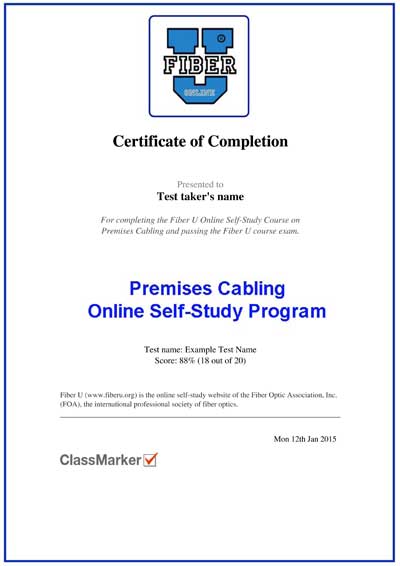
Please
note: receiving this Fiber U Certificate of
Completion does not include FOA certification but it does
become documentation of your knowledge of fiber optics and
should be part of your portfolio of documented knowledge,
other training and work experience that can qualify you to
apply for FOA direct FOA certification through the FOA "Work
to Cert" program.
For
more information on the Fiber U Certificate of
Completion program, go
here.
For more information on
the FOA and its certification programs, go to the FOA
page on certification.
For information on the FOA "Work to Cert" direct
certification program for those with industry experience, go
here.
FOA
Certification Programs
FOA
Certification
Unless you already have field experience, you can't get FOA CFOT®
or CPCT certified just by taking online courses at Fiber U because
you can't develop hands-on skills needed for fiber optics on a
computer! But using these self-study courses, you can prepare
yourself for training at one of our hundreds of FOA-Approved
schools around the world, refresh your knowledge from your own
CFOT training or study for FOA exams if you are experienced in
fiber optics and want to apply for direct certification.
If you do
have field experience, you may qualify for the FOA "Work to Cert"
direct certification program.
For
more information on the FOA and its certification programs,
go to the FOA
page on certification.
For information on the FOA "Work to Cert" direct
certification program for those with industry experience, go
here.
FOA Resources
Reference Books
from The FOA

FOA has
created these textbooks to be used in training for FOA
certifications and as reference books for contractors,
installers and end users of fiber optics. Many are cited in the
Fiber U self-study courses. All FOA books are available in
printed form at Amazon.com, and some also as eBooks on the
Amazon Kindle or as Apple iBooks for the iPad/iPhone/iPod.
Go
here for more information.
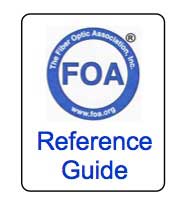
Learn
more about fiber optics at the FOA
Online Reference Guide to Fiber Optics - almost
one thousand pages of technical information on fiber optics.
It's the world's most used and trusted site for technical
information on fiber optics.

The
FOA is using YouTube to host a large number of instructional
videos including lecture series on fiber optics and premises
cabling plus dozens of hands-on videos.
See the FOA Lecture Series and dozens of hands-on instructional
videos and lectures about fiber optics and premises cabling on the
FOA YouTube Channel - "thefoainc"
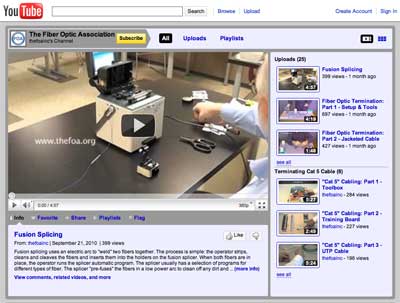
Here
is a listing of all the current FOA YouTube Videos
- Getting Started Guides
Take the
short course "Fiber
Optics In Communications - And How It Works" - an
introduction to fiber optics in communications and fiber optic
technology.
Or read these two introductory guides:
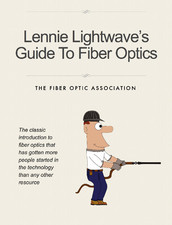
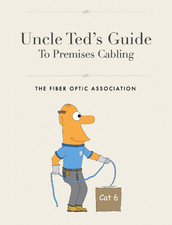
These two guides
are simple introductions to the subjects. They will explain the
applications, jargon, components and installation in a quick
overview. Lennie
Lightwave's Guide to Fiber Optics and
Uncle Ted's Guide to Communications Cabling
are available free online.
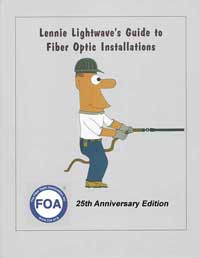
Lennie's Guide
is now also available in print - a special 25th anniversary
edition in full color! Buy
it on Amazon.
Fiber U
History
Fiber U
began as a training conference run by Fotec, the fiber optic test
equipment company started by Jim Hayes, now FOA President. Fiber U
combined lectures by many highly knowledgeable instructors and had
participating manufacturers to provide hands-on training on their
equipment. During the 1990s, dozens of Fiber U conferences were
held as a standalone conference and as part of major trade shows
and meetings. Conferences had up to 250 students and 40
vendors, taking over complete hotels and filling conference areas
- even parking lots - with training sessions.
After
the 1994 conference, the Fiber U instructors decided that the
fiber optic industry was ready to have its own professional
society and the FOA was born.
Fiber U also pioneered online training, starting in 1997 using
techniques just like we use today which we learned from a teacher
who was a summer intern at Fotec.
Photos
from the original Fiber U conferences.

Lennie Lightwave was the cartoon mascot created for the original
Fiber U conference in 1993. Lennie has been called the most famous
guy in fiber optics. Lennie Lightwave's Guide to Fiber
Optics was published 20 years ago as a simple, easy to understand
introduction to fiber optics. The web version of Lennie
Lightwave's Guide to Fiber Optics
was one of the first commercial web pages ever and introduced many
people to fiber optic technology. Now Lennie's Guide and Uncle
Ted's Guide to Communications Cabling,
the premises cabling equivalent, are still two of the most popular
sites for getting started in the fiber optics and premises cabling
business.
|
